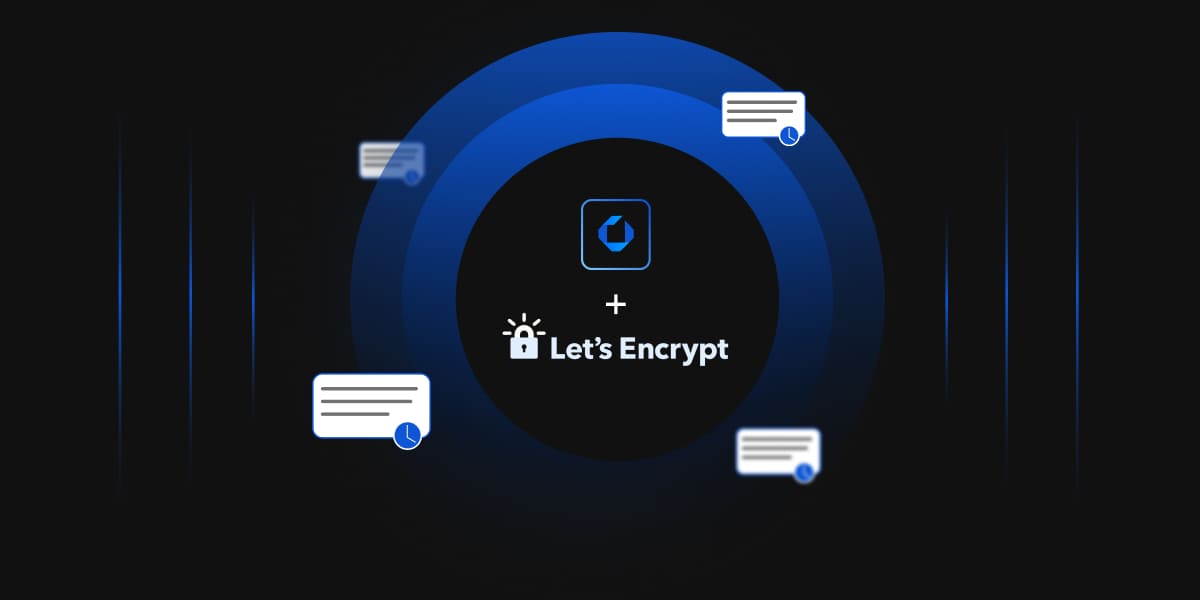- Managing SSL the Right Way: The Power of Certificate Lifecycle Management
- From Issuance to Expiry: Mastering SSL with Lifecycle Management
- Avoiding Outages and Breaches Through Certificate Lifecycle Control
- Automating SSL: The Role of Lifecycle Management in Modern PKI
- Keeping SSL Certificates Secure and Compliant with CLM
- How Encryption Consulting Can Help You
- Conclusion
SSL/TLS certificates play a vital role in securing online communication, protecting sensitive information, and establishing user trust. However, as organizations grow and adopt hybrid, multi-cloud, or CI/CD-driven environments, managing certificates manually becomes increasingly complex and error-prone. The fast pace of DevOps and the distributed nature of modern infrastructure make it especially challenging to scale SSL management effectively without automation.
That is where Certificate Lifecycle Management (CLM) plays a significant role.
In this blog, we are going to explore how effective CLM simplifies SSL certificate management, mitigates human error, supports compliance, and enhances visibility across your digital infrastructure.
Managing SSL the Right Way: The Power of Certificate Lifecycle Management
CLM is the systematic process of issuing, discovering, tracking, renewing, and revoking digital certificates in a systematic and centralized manner. Below is a more detailed breakdown of its key benefits and why it plays a vital role in managing SSL the right way:
-
Automation
- Handles certificate issuance, renewal, and replacement automatically, with no manual intervention needed.
- Leverages standard protocols like ACME and SCEP to streamline integration with Certificate Authorities(CAs), devices, and systems.
- Minimizes the risk of service outages caused by expired certificates.
- Eliminates repetitive, time-consuming manual tasks, reducing the operational burden on IT and security teams.
-
Visibility
- Provides a centralized inventory of all digital certificates across the organization.
- Offers real-time monitoring and alerts in case of expiry or misconfigured certificates.
- Helps to identify certificates that are unused or non-compliant, which helps in reducing security risks.
-
Security
- Enforces strict access controls and policies for certificate requests and usage.
- Prevents unauthorized certificate issuance or misuse of certificates.
- It also manages to reduce human errors, a major cause of mismanaged SSL environments.
-
Compliance
- Supports regulatory requirements and aligns with the internal security policies.
- Maintains comprehensive audit logs for all certificate-related activities.
- Enables faster, more precise reporting during security audits or compliance reviews.
From Issuance to Expiry: Mastering SSL with Lifecycle Management
For effectively managing SSL/TLS certificates, just deploying them is not enough; it also demands end-to-end management of their entire lifecycle. From initial issuance to timely renewal and eventual expiry or revocation, every stage plays a crucial role in ensuring that security and trust are uninterrupted. This becomes especially important in today’s hybrid environments, where certificates are distributed across cloud platforms, edge devices, and IoT ecosystems.
CLM provides the automation, visibility, and control needed to handle each phase with confidence and efficiency, regardless of where the certificate resides.
Let’s take a deeper look at how CLM supports every step of the SSL certificate lifecycle:
-
Issuance
- Structure certificate request workflows that reduce manual intervention and delays.
- Ensures that all certificate requests meet internal security and compliance standards.
- Supports CSR (Certificate Signing Request) validation flows, including manual approval processes and automated policy checks, to maintain control and security.
- Integrates with trusted CAs, enabling quick issuance from preferred internal or public CAs.
- Tracks request history and approvals to ensure the certificate process is traceable and accountable.
-
Discovery
- Scans your networks and systems to find all deployed certificates, which also include those that were manually installed, forgotten, or undocumented.
- Supports both agent-based and agentless discovery methods—offering flexibility depending on your environment’s needs and constraints.
- Uncovers unsafe or unauthorized certificates that could lead to hidden vulnerabilities or security risks.
- Giving teams a complete, up-to-date view of all SSL assets across environments through a centralized certificate inventory.
- Categorizes certificates by owner, department, and use case, simplifying management and ownership accountability.
-
Tracking & Monitoring
- Continuously monitors certificate status, including expiration dates, configuration details, key strength, and issuer information—tasks that are nearly impossible to manage manually at scale.
- Sends proactive alerts and notifications well in advance of expirations, policy violations, or configuration issues, helping teams avoid last-minute surprises and downtime.
- Promotes cryptographic hygiene by detecting deprecated key lengths, outdated hashing algorithms, or misconfigured parameters, ensuring that all certificates align with evolving security standards.
- Provides role-based dashboards and reports, making it easier for teams to track performance, risk exposure, and certificate health in real time.
- Detects unusual activities—such as unexpected changes or unknown issuers—and flags them for immediate investigation to prevent potential misuse or compromise.
-
Renewal
- Makes sure that all the certificates are renewed to ensure no certificate is forgotten or allowed to expire; this helps in eliminating one of the most common causes of service outages.
- Supports renewing multiple certificates together, which helps in saving time and reducing friction for teams managing hundreds or thousands of certificates.
- Enables seamless replacement of expiring certificates without disrupting active services or user trust.
- Integrates with DevOps pipelines and CI/CD tools to renew certificates automatically in the ever-changing and fast-moving environments.
-
Revocation & Expiry
- Provides quick and secure options to revoke certificates that are no longer needed or trusted.
- Prevents expired or revoked certificates from being used, which helps in maintaining continuous service availability and trust with users.
- Maintains detailed audit logs and compliance records, which help organizations to prove proper certificate handling during security assessments or audits.
- Supports certificate replacement workflows, which ensure the replacement of revoked certificates with new valid ones.
Avoiding Outages and Breaches Through Certificate Lifecycle Control
Digital identities that are unmanaged or poorly tracked can lead to unexpected service outages and serious security breaches. In fact, even a single expired or misconfigured SSL/TLS credential can bring down critical systems, disrupt user access, and erode trust. That’s why CLM is more than just a best practice—it’s a necessity for any modern enterprise.
Here’s how effective CLM helps in avoiding costly outages and preventing breaches:
-
Proactive Expiry Alerts
- The team is notified in advance about the upcoming expirations through automated notifications and reminders.
- Reduces the risk of downtime caused by overlooked certificate renewals.
-
Eliminating Blind Spots
- CLM tools perform continuous discovery across all environments, identifying certificates that are forgotten, rogue, or shadow.
- Helps eliminate vulnerabilities caused by unmanaged or expired certificates.
-
Automated Renewal & Replacement
- Prevents lapses in encryption by auto-renewing certificates before expiry.
- Seamless transitions ensure that the users and systems stay secure and connected without interruption.
-
Reduced Human Error
By automating repetitive and sensitive certificate tasks, CLM reduces the likelihood of mistakes that often lead to misconfigurations or missed updates, as there is no manual intervention.
-
Improved Response to Compromise
If a certificate is compromised or no longer trusted, CLM immediately removes and replaces it to reduce the threat.
-
Audit-Ready Compliance
- Maintains logs and records of all certificate activities to show strong security management and compliance with industry standards.
- Real-world incidents like the Equifax breach, where an expired certificate prevented malware detection for over 19 months, or the Microsoft Teams outage in 2020, caused by a single expired certificate, highlight the critical need for continuous compliance and vigilant lifecycle control.
Automating SSL: The Role of Lifecycle Management in Modern PKI
Evolving digital infrastructures make managing SSL/TLS certificates manually harder, error-prone, inefficient, and risky. In modern Public Key Infrastructure (PKI) environments, where certificates secure everything from websites and applications to APIs and IoT devices, automation is no longer optional. This is where CLM becomes a crucial component.
Here’s how CLM supports automation in modern PKI:
-
End-to-End Automation
- CLM helps automate the entire certificate lifecycle from issuance and discovery to renewal, revocation, and replacement.
- Manual intervention is reduced, which helps in saving time and minimizing human errors.
- Seamless PKI Integration
-
Supports DevOps & CI/CD Pipelines
- Seamlessly integrates with DevOps workflows and container tools like Kubernetes, Ansible, and Jenkins.
- Helps developers to automatically provision and rotate certificates without disrupting workflows.
- Supports integration with secrets management solutions such as HashiCorp Vault, Azure Key Vault, and similar tools, ensuring that private keys and sensitive credentials are securely stored and accessed during automation.
-
Dynamic Environments Ready
- Perfect for cloud-native, hybrid, and microservices setups where certificate changes are required often.
- Adapts automatically to changes in scale, IPs, or service endpoints.
-
Policy-Based Management
- Automatically applies pre-defined policies to control key features of the certificate, such as key length, validity period, and SANs.
- Makes sure all the issued certificates maintain consistent security and compliance across.
-
Operational Efficiency & Visibility
- Provides a centralized dashboard for tracking all certificates across environments.
- Helps security teams respond quickly, plan renewals on time, and maintain continuous uptime.
- Adapts seamlessly to ephemeral services such as containers, serverless functions, and short-lived workloads, ensuring that even transient environments remain secure and compliant without manual oversight.
Keeping SSL Certificates Secure and Compliant with CLM
SSL/TLS certificates are important for keeping the communication secure, but manually managing them can be risky, from expirations and misconfigurations to compliance failures. CLM solves this problem by automating processes and keeping control over the certificate lifecycle.
How CLM ensures security and compliance:
- Strong Security: Enforces crypto policies, blocks unauthorized access, and integrates with HSMs for securing the key storage.
- Compliance Enforcement : Meets compliance standards (e.g., NIST, PCI-DSS), maintains audit trails, and ensures that policies are followed. Supports integration with compliance and vulnerability scanning tools such as Qualys, Nessus, or similar platforms to help identify outdated certificates and encryption weaknesses.
- Expiry & Renewal Automation: Prevents downtime by renewing certificates in a timely manner and keeps detailed renewal records for audit checks.
- Standardized Practices: Applies consistent certificate settings organization-wide and eliminates certificates that are unauthorized or risky.
- Real-Time Visibility: Provides real-time updates and alerts for tracking the certificate health, risk, and compliance.
How Encryption Consulting Can Help You
Managing SSL certificates manually is no longer feasible in today’s dynamic, cloud-first world. That’s where Encryption Consulting steps in—with our robust CertSecure Manager, we empower organizations to take complete control of their SSL/TLS certificate lifecycle with automation, visibility, and compliance at the core.
Here’s how CertSecure Manager simplifies SSL management for your enterprise:
- Comprehensive Automation: From certificate issuance to renewal and revocation, CertSecure Manager automates every stage of the lifecycle, minimizing human errors, eliminating expired certificates, and significantly reducing downtime risks.
- Centralized Certificate Visibility: Gain a single-pane-of-glass view into all your SSL certificates across hybrid, cloud-native, and on-prem environments. Discover undocumented or rogue certificates and ensure everything is inventoried and compliant.
- Strong Security & Policy Enforcement : With role-based access control, CSR workflow approvals, and policy enforcement for certificate usage (wildcard restrictions, key length, etc.), our solution ensures that your certificates follow best practices and internal standards at all times.
-
Seamless Integrations
CertSecure Manager integrates effortlessly with:
- Internal & external CAs (Microsoft AD CS, Digicert, etc.)
- DevOps tools (Jenkins, Ansible)
- PKI infrastructure and HSMs
- ITSM platforms (ServiceNow, email)
This means certificate provisioning, renewal, and tracking are embedded directly into your existing workflows.
- Proactive Monitoring & Alerts: Avoid last-minute surprises with real-time alerts and scheduled notifications about upcoming expirations, policy violations, or risky certificates. All activities are logged and audit-ready.
- Audit & Compliance Made Easy: Support for industry regulations like PCI-DSS, HIPAA, and NIST is built in. With complete audit logs, role-based reports, and policy-driven issuance, you'll always be prepared for internal reviews or external audits.
-
Flexible Deployment Options
Whether you prefer on-premises control, cloud-based scalability, or a fully managed SaaS experience, CertSecure Manager offers deployment flexibility to match your infrastructure strategy. It's built to support zero-trust architectures by enforcing strict identity validation, least-privilege access, and role-based controls across all certificate operations.
Additionally, the solution supports multi-tenant environments, enabling organizations to segment certificate management by teams, departments, or clients—ensuring logical separation, delegated administration, and policy isolation without compromising security or oversight.
We don’t just provide a tool—we deliver a complete certificate lifecycle solution. CertSecure Manager helps you eliminate outages, improve operational efficiency, and maintain trust across your digital ecosystem.
Conclusion
Managing SSL certificates isn’t just a behind-the-scenes task; it’s a critical part of maintaining trust, uptime, and security across your digital landscape. As environments become more dynamic and certificate volumes grow, manual processes fall short, leading to avoidable outages and vulnerabilities. That’s where CLM steps in to make a real impact. With automation, visibility, and policy enforcement at its core, CLM helps you stay ahead of risks, not just react to them.
Encryption Consulting’s CertSecure Manager takes this a step further, offering a powerful, centralized solution to simplify and secure every stage of your certificate lifecycle. If you’re looking to eliminate guesswork and take control of your SSL management, CertSecure is built to help you do exactly that.
- Managing SSL the Right Way: The Power of Certificate Lifecycle Management
- From Issuance to Expiry: Mastering SSL with Lifecycle Management
- Avoiding Outages and Breaches Through Certificate Lifecycle Control
- Automating SSL: The Role of Lifecycle Management in Modern PKI
- Keeping SSL Certificates Secure and Compliant with CLM
- How Encryption Consulting Can Help You
- Conclusion




